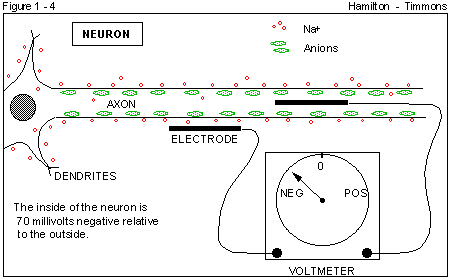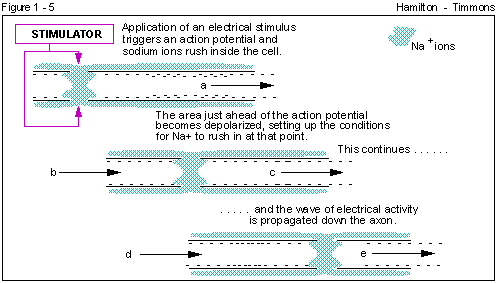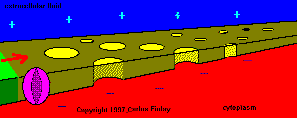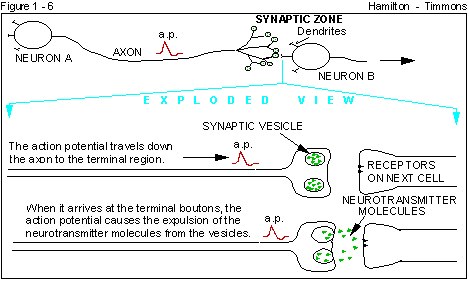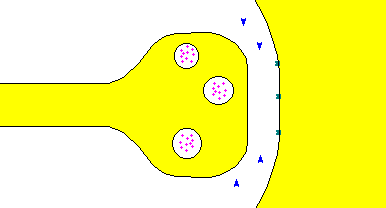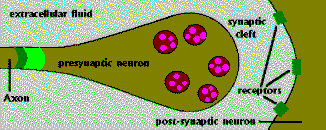Structure of the Neuron
Filaments that receive information from other neurons,
receptors, etc.
Contains nucleus of the cell.
Manufactures enzymes and molecules to maintain cell life.
NOTE: In the PNS, a group of cell bodies and dendrites are
called ganglion and in the CNS, it would be called a
nucleus.
Filament that transmits information to the dendrites or
soma of other neurons.
NOTE: In the PNS, a group of axons is called a nerve and in the
CNS it is called a tract.
Insulation on axon to improve speed of transmission.
Also insulates axon from activity of other neurons.
Other manufacturing, nurturing, and clean-up tasks
Where neurotransmitters are stored.
How Neurons Fire
Propagation of impulse within neuron (electrical).
Transmission of impulse between neurons (chemical).
Neuron at rest.
Not firing.
Stable, negative charge inside neuron relative to outside (- 70
mV)
(Hyperpolarization)
Sodium (Na+) outside the neuron.
Neuron receives sufficient stimulation from receptor,
other neurons, etc.
Na+ ions rush in.
Interior of axon becomes positive relative to the outside (+ 40
mV)
(Depolarization)
This release of energy passes down the axon and is the
firing of the neuron.
Once neuron fires, resting potential returns.
Once neuron fires, the impulse moves down the axon at the
same intensity.
No stopping it.
While there are differences in speed of transmission
between neurons, increase in neuron stimulation doesn’t cause
stronger impulse. Speed and electrical change remains the same
regardless of intensity.
Stronger stimulation leads to more frequent firing of the
neuron or more neurons activated.
- Absolute Refractory
Period
Brief period of time after firing when neuron won’t fire
no matter how much stimulation given.
As brief as 1/1000 of a second. HOWEVER, means a limit as to
how many times neuron can fire per
second (the maximum is 500-600 times/second).
- Think of neuron like a
toilet that works well
Information flows in 1 direction (out to the
sewage!)
It is all or none - the toilet doesn't have "half flush"
days
There is a period of time that, no matter how much you jiggle
the handle, no flushing will occur
How Neurons Send
Messages
Small gap or cleft between the axon of one neuron and the
dendrite of another.
Contains synaptic vesicles
Chemical substances released by synaptic vesicles.
Taken up by the axon of the receiving neuron
Work in Lock and Key fashion
Inhibitory (
IPSP): tells the neuron
NOT to fire)
Excitatory (
EPSP): tells the neuron to
fire)
If gets more excitatory information than inhibitory, neuron
will fire, if more inhibitory than excitatory, will not
fire.
A neuron AT REST will occasionally spontaneously fire
Excitatory
information - causes depolarization (an increase in
neural firing)
Inhibitory
information - causes hyperpolarization (a decrease in
neural firing)
Neurochemicals
* Selected neurotransmitters
o
Acetylcholine
+ motor, learning memory, contract muscles, REM sleep
+ Alzheimers, black widow spider bite
o
Dopamine
+ motor, attention, emotions
+ Parkinson’s, schizophrenia, drug abuse
o
Norepinephrine
+ regulation of arousal, eating and sleeping
o
Serotonin
+ arousal, sleep, learning, mood, aggression, appetite
+ depression
o
Endorphins
+ Pain reduction, pleasure
+ possibly related to "runner’s high"



